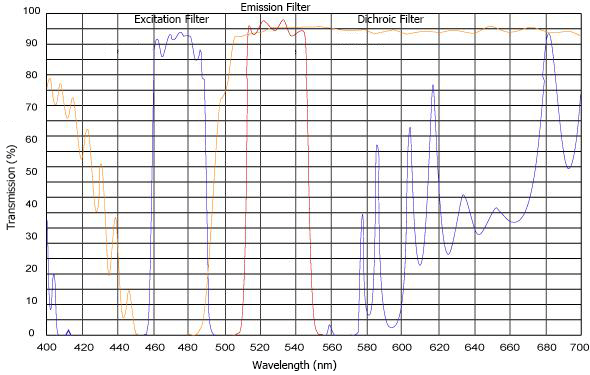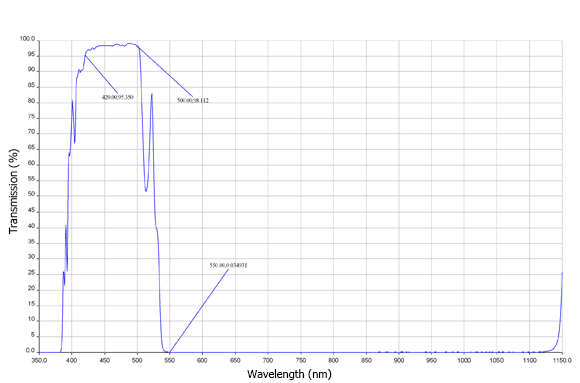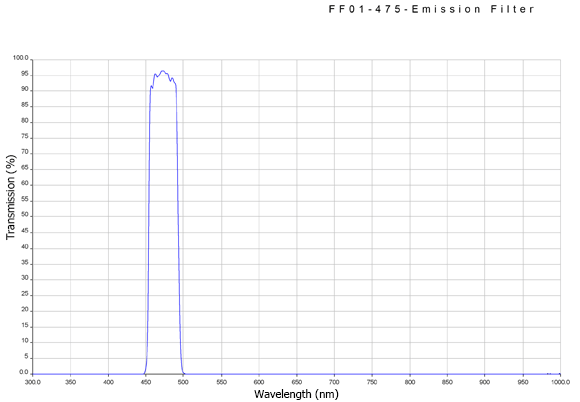Fluorescence filters are at the heart of every Fluorescence optical device, and high quality filter sets are essential for high definition imaging and fluorescence microscopy. At Shanghai Optics we produce fluorescence filters for a wide range of applications in the form of filter cubes and filter wheels.
Fluorescence microscopes are designed to detect the fluorophores in a sample; either naturally occurring fluorophores or those used as dyes and labels. These fluorophores absorb energy in specific wavelengths (excitation range), and emit it in a different wavelength (emission range). This allows us to identify fluorophores by absorption and emission.
More precisely, as each fluorophore has a unique excitation spectrum and a unique emission spectrum, each peaking at a specific wavelength, they can be distinguished by either their excitation spectrum, by their emission signal, or by their Stokes shift, which is the distance between peak excitation and peak emission. This is the basic principle behind all fluorescence microscopy systems, whether it be a simple system such as a epifluorescent microscope or a more complex setup such as those used in multiphoton systems.
Each fluorescence filter cube features three distinct optical filters: an excitation filter a dichroic mirror and an emission filter.
The excitation filter, otherwise called an exiter, is a bandpass filter designed to pass only the wavelengths of light which are absorbed by the fluorophore. By doing so, it minimizes excitation that might be caused by the light source and other sources of fluorescence and also blocks excitation wavelength light in the flurorecence emission band. The minimum transmission of this filter is what will determine the brightness or brilliance of the final image. In general, an excitation filter should have a minimum of 40% transmission; transmission of greater than 85 percent will give a bright, well-lit image. Optical density determines the background darkness, and should be at minimum 3.0 but preferably closer to 6.0. The excitation filter should be chosen so that the center wavelength (CWL) is close to the peak excitation of the fluorophores, and the bandwith is completely within the fluorophores excitation range.
The dichroic mirror is a specialized edge filter sometimes called a dichromatic beamsplitter. When used at a 45 angle of incidence, it is able to reflect light in the wavelengths of the excitation band and transmit light from the emission band to the emitter and on to the detector.
The third component of the fluorescence filter is the emitter. This is also an bandpass filter, and passes exclusively light emitted by the fluorophore. Excitation light and all other light outside, both UV an IR, are blocked out effectively by the emitter filter.



Our standard high performance fluorescence filter cubes are carefully designed to pass the appropriate wavelengths for high-brightness imaging while blocking irrelevant light that might decrease contrast. Since both system autoFluorescence and excitation light is blocked, our filters are able to provide a high signal to noise ratio and the dark background needed for precise imaging.
When a bright image is more crucial than high contrast, a longpass edge filter may be used as an emission filter in place of the bandpass filter. Longer wavelengths of light will then be transmitted, producing a well-lighted brighter imager.
When a multiband excitation filter is combined with a multiband emission filter and a polychroic rather than dichroic beamsplitter image with all fluorescent tags will be formed. This type of filter set is referred to as full-multiband and can be used with multiple fluorophores.
At Shanghai Optics we produce a wide range of fluorescence sets that are designed with the excitation and emission filters suitable for each commonly used fluorophore. For specialized applications, such as those using multiple fluorophores, alternate dichroic filters or laser sources, we are able to produce custom filter sets upon request. Please contact us to discuss the specific requirements of your application and to get a consultation and a price quote.
Fluorescence Filter Factory Standards
| Diameter: 18.0, 20.0, 22.0, 25.0mm | Diameter Tolerance: +0/-0.1mm |
| Passband Transmission: T>90% | Clear Aperture: >80% |
| Surface Quality: 60-40 | Angle of Incidence: 0° +/- 5° |
| Beam Deviation: <11 arc sec. | Transmitted Wavefront: 1/4λRMS@633nm |
| Operating Temperature: -45°C~85°C | Environmental Durability: MIL-STD-810F |
| Temperature Dependence: <5ppm/°C | Blocking OD>6.0(typical): UV-700nm, λc<500nm UV-925nm, λc>500nm |
| Physical Durability: MIL-C-48497A | Substrate: Low Fluorescence BK7 or Equivalent |
| Central Wavelength(nm) | Bandwidth | Transmission(%) | Thickness(mm) | Typical Application |
| 438 | 24 | 90% | 5.0 | CEP Excitation |
| 447 | 60 | 90% | 3.5 | DAPI Emission |
| 472 | 30 | 90% | 5.0 | GFP Excitation |
| 482 | 35 | 90% | 5.0 | FITC Excitation |
| 483 | 32 | 90% | 3.5 | CFP Emission |
| 500 | 24 | 90% | 5.0 | YFP Excitation |
| 510 | 84 | 90% | 3.5 | FURA2 Emission |
| 520 | 35 | 90% | 3.5 | GFP Emission |
| 531 | 40 | 90% | 5.0 | CY3 Excitation |
| 536 | 40 | 90% | 3.5 | FITC Emission |
| 542 | 27 | 90% | 3.5 | YFP Emission |
| 543 | 22 | 90% | 5.0 | TRITC Excitation |
| 562 | 40 | 90% | 5.0 | Texas Red Excitation |
| 593 | 40 | 90% | 3.5 | TRITC/CY3 Excitation |
| 624 | 40 | 90% | 3.5 | Texas Red Emission |
| 628 | 40 | 90% | 5.0 | SY5 Excitation |
| 692 | 40 | 90% | 3.5 | SY5 Emission |